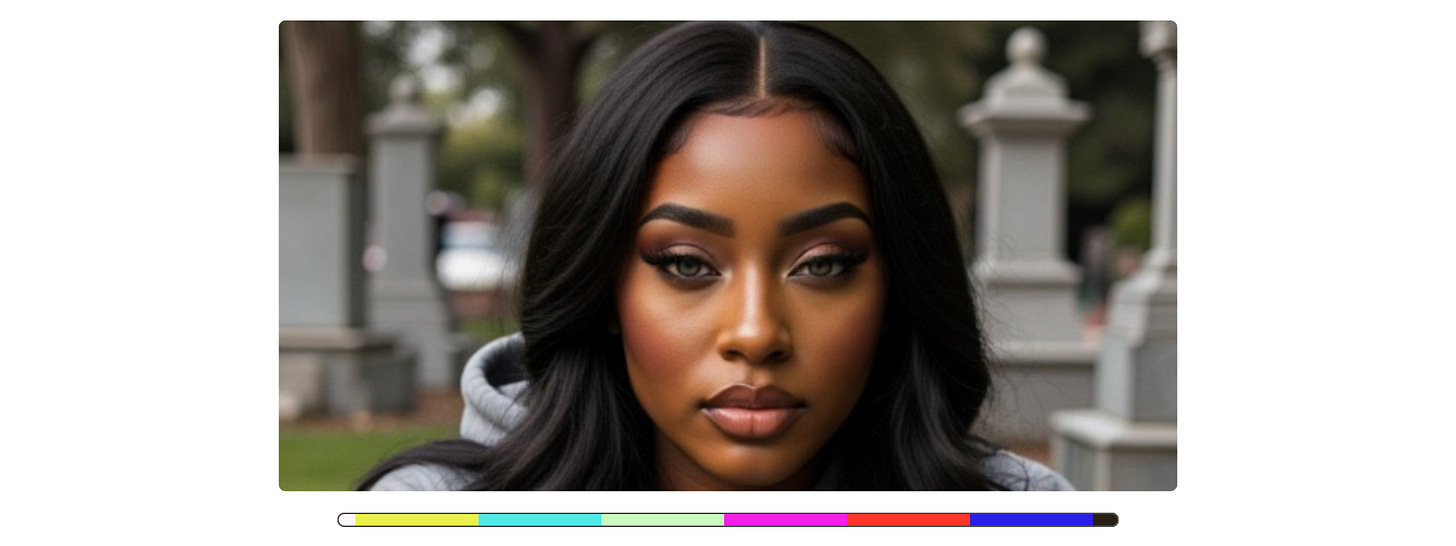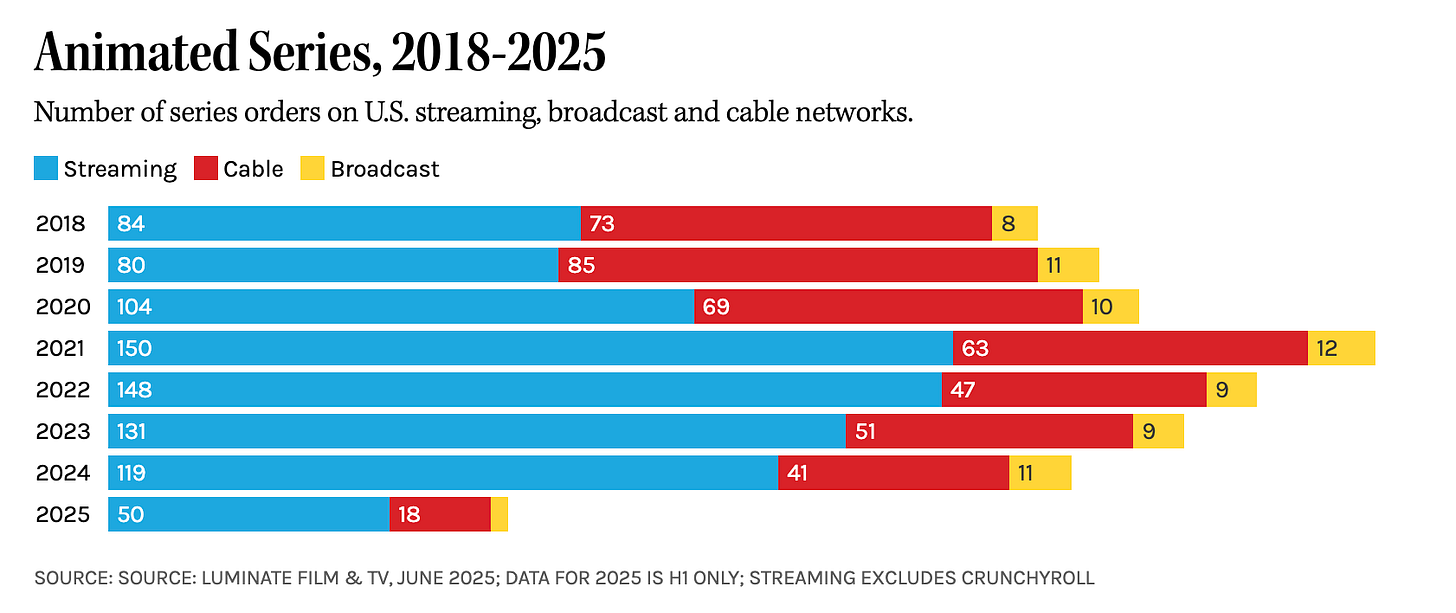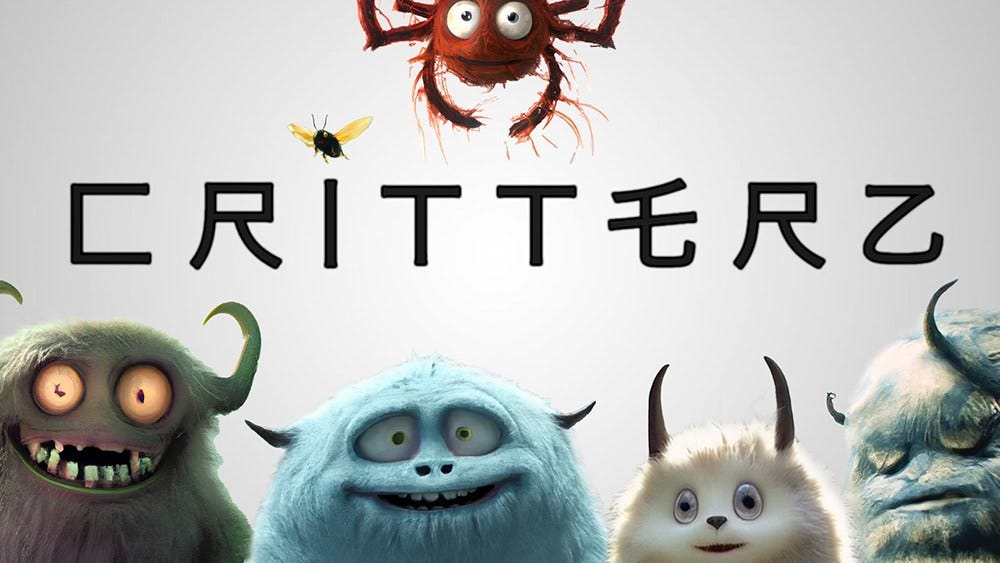Uncanny Valley
· Remaking memories · AI music deals · State of animation ·
There is an uncanny feel to this week as we are prodded to question our acceptance of AI in our own lives and in art; indeed, question our own memories.
🎧 Prefer to listen? Hit play above to listen to me read this week’s dispatch.
Music, AI & Poetry: a surge in AI music, ghost tracks, and an AI generated ‘artist’.
Curated/Cuts: FT’s dramatic short challenges our memories, and AI; Visa has a foray into humour.
Cartoon slow motion: stories from the animation scene- an industry slowdown, Asian moves, the spectre of AI.
Made for Youtube: Some takes on the announcements from Youtube’s event.
Music, AI & Poetry
Music streaming service Deezer receives over 30,000 fully AI-generated tracks every day – that’s more than 28% of their total daily delivery.
In January, Deezer reported that roughly 10 % of all content delivered to the platform was AI generated. This number increased to 18% in April and has now reached a record breaking 28%.
AI generated music has fast become a very real thing on streaming services, and increasingly something that is more ‘believable’. Many challenge that the likes of Spotify and Apple are just not doing enough, in words or action.
Liz Pelly, a music journalist: “I think a lot of streaming companies or AI companies are not counting on people just stumbling across this [kind of] material and thinking it’s great. They’re counting more on people not noticing it in the background, in an algorithmic playlist recommendation or something like that… they’re trying to game the system.”
From an artist POV (and, I daresay, a fan’s), this overlaps also with with “ghost artists”. These are intentionally generic tracks uploaded under fake names, some even commissioned by streamers themselves.
For example, Spotify’s program ‘Perfect Fit Content’ commissions music generic enough to be plonked unnoticed into genre-based and functional playlists. Think Focus, Study music, Jazz, Ambient, Electronic. Spotify or any streamer with similar licensing agreements own this music. And so doesn’t pay royalties.
Ghost artists also come from humans looking to game the system, of course. AI-generated music will only make it easier to play this scale game. (This piece does a good job of looking at this; it is about Liz Pelly’s book, Mood Machine: The Rise of Spotify and the Cost of the Perfect Playlist).
Deezer, on their part, likes to draw the distinction very clearly. “Deezer remains the only streaming provider to tag 100% AI-generated content and exclude it from recommendations – championing fairness and transparency in the music industry.”
Xania
Meanwhile, a ‘music artist’ made with generative AI has reportedly signed a $3m deal with a label. Xania Monet is an R&B artist avatar created by Talisha Jones, a Mississippi poet and owner of a design studio. She has made Monet’s tracks with her own lyrics + gen-AI service Suno. Suno, you will recall, has made many waves since 2024 for the realistic music they are able to generate, and also for the copyright infringement they have all but clearly been involved in.
She/the AI has a digital audience of about 465,000 monthly listeners on Spotify- the song ‘How Was I Supposed to Know’ reached the top slot on R&B Digital Song Sales! The AI’s catalog has garnered “9.8 million on-demand official U.S. streams,” Billboard said.
My take- I find it easy to recoil from AI-generated music, because I have always found the art form highly resonant. I feel deeply when a song or track connects with me, and as with much art, I acknowledge the artist’s efforts or journey that shaped the track. Something generated from a machine that has learnt to spew out notes cleverly, seems instinctively hollow.
While the resistance and backlash to AI music is not small, it is worth pausing to consider that clearly, there are execs out there willing to plonk cash down for such deals.
Romel Murphy manages Talisha Jones, and claims, “This is real music, it’s real R&B. There’s an artist behind it.”
Elsewhere, artist Kehlani railed against it, bemoaning “There is an AI R&B artist who just signed a multimillion-dollar deal and has a top-five R&B album, and the person is doing none of the work… In the creative arts in which people have worked hard for, trained for, slept on the floor for, got injuries for, worked for their entire lives, I’m sorry. I don’t respect it.”
🎬 Curated/Cuts.
1. Recall Me, Maybe
The Financial Times original content team has had some interesting forays. It is a tricky balance for them to find content that ‘makes sense’ in their relatively niche space, while at the same time meeting the standards that ‘premium’ digital content from brands has grown to have.
Their latest attempts to tackle the thorny perspectives around AI, and they choose to do it via a scripted short film. The inimitable Stephen Fry, together with Gemma Whelan are father-daughter in a film written by David Baddiel, exploring AI, memory and truth. A gentle but not entirely comfortable collision of dementia, remembering, acceptance and truth.
‘Recall Me, Maybe’ uses human remembrance as a vehicle— both practical and emotional— to question our instinctive responses to memories, as well as technology’s place in shaping them. It challenges us to pause and consider our values, and how much they underpin our dalliances with generative AI and LLMs.
2. Cyphr
Some fresh work from Holographik, in a branding with a full suite of assets. This is their work for Cyphr, a “culture-first venture studio reshaping how fans connect with sports, music, and entertainment.” Project included an identity system, website, assets and templates. Striking.
3. Visa decides to laugh
Visa has some fun with their new spot that extends their promise of being available everywhere. They worked with Ryan Reynolds team at Maximum Effort in a spot that takes a stab at the ill-fated Fyre festival. ‘Everywhere you want to be…. and some places you really don’t’ does set the stage for them to have more fun with the brand creatively.
Have to agree with this from their CMO Frank Cooper III, “Historically, humor has not played a central role in our brand. I think the view has been that financial services and payments have always been very serious categories. But in a world where we’re battling for attention, the hardest part is having stopping power — and humor is a great angle in.”
That’s Ryan Reynolds on voice, this is from his team at Maximum Effort.
Made for Youtube
The Youtube event had a slew of new tools and options for creators and advertisers. The most buzz seems to be the ability to insert ads into videos dynamically, and hence retrospectively. Yes, like TV. This can bring all sorts of positives for Youtubers, and notably also podcasters, who are used to monetising in this way on their audio-only platforms.
There’s also now the ability to collab with other creators, auto-dubbing, A/B testing and updates to their Live platform.
Jim Louderback’s comprehensive analysis has the recurrent themes of diversifying, not building on rented land; advice to not “bet your business on YouTube alone”; and the big Red squeezing creators in the long run, while boxing out adjacent startups.
For creators, that means convenience in the short run, but also less choice, fewer independent tools, and deeper dependency on YouTube’s roadmap. And with their AI push, YouTube is signaling it wants to dictate the future of creation, even in the teeth of a powerful backlash.
Elsewhere, Seth Silver has some key takeaways for podcasters.
Slow Mo Animation?
Some bits around the animation space that are, more by chance than design, connected. Momentum and slowdowns might be usual, but global forces and AI dominate the potential ways forward for animation.
Audrey Schomer has a new report out for Luminate, looking at the state of animation, plus the place of AI in it. The headline? “Animation is in turmoil”. Its a paid report, but some key takeaways include:
Kids’ Live TV viewing has crashed from 24% to just 4% since 2017.
The streaming production boom has ended. Series orders are in sharp decline.
Adult animation and anime still seem to be surging despite an overall contraction.
Producers have shifted focus to test-running children’s IP on YouTube before investing in full series.
Apple’s tumble to abandon animation in streaming is another highlight, and this piece look at it in some detail, saying “the service has seemingly all but abandoned cartoons.”
AI- 55% of the industry expects a major impact on animators in the next two years.
The use of generative AI within the animation industry remains divisive. Proponents view it as revolutionary, with the ability to accelerate production and reduce costs. Critics and artists might view it as ‘dirty’ technology, with concerns around legal, creative and ethical implications.
Nearly half of gen AI users surveyed admitted they’d looked to mimic the work of specific creators or studios (think Studio Ghibli). Concept artists, who often do the visionary design work before production, clearly view this as an existential threat.
Much remains open ended. Will animation continue to be craft-driven or move towards “good-enough” approaches sitting atop efficiency?
Highlights gathered via Luminate’s Jennifer Gordon, animationmag, cartoonbrew.
AI animation feature film becomes a reality. Circa early 2024, I watched Critterz at a small AI showcase. All characters were generated using Dall-E; then a team of animators created an entertaining short from it (shaped by Chad Nelson & Nik Kleverov). Now, OpenAI is putting muscle behind it to make the Critterz feature film, to hit theatres in 2026. There’s no cash , but OpenAI is providing all the gen AI firepower for it to come to life.
Screenrant has a look at Asian animation films doing well at the global Box Office, though it admits being hard-pressed to really call this a trend yet. It touches on outlier Ne Zha 2, King of Kings, Jumbo and the latest Demon Slayer (which, after the article came out, has incredibly crossed half a billion dollars globally).
Shoutout: I also publish some eclectic storytelling on Coffee & Conversations. Last week I was sucked into Pink Floyd’s Wish You Were Here by their 50th anniversary stunt, and an unlikely dalliance between of photography and knitting! Have a read.










